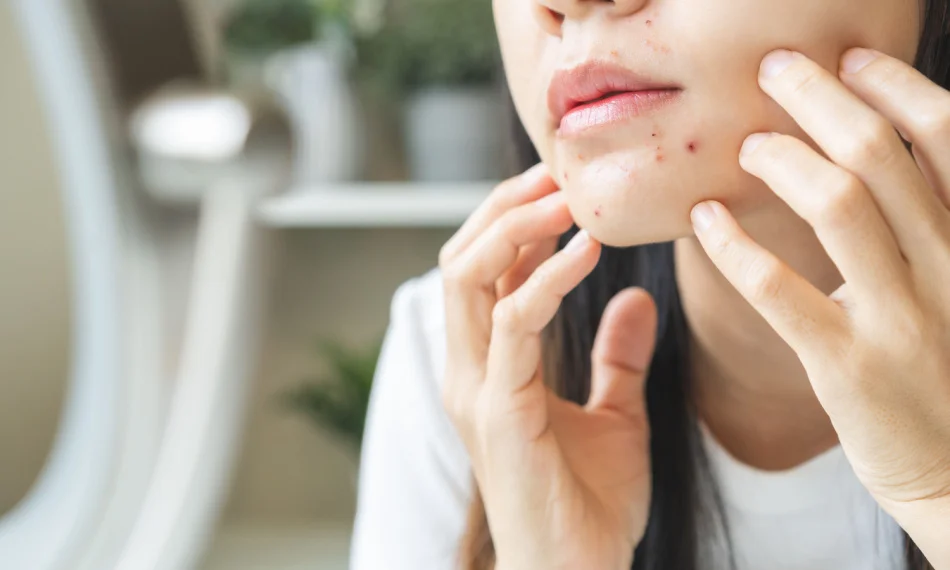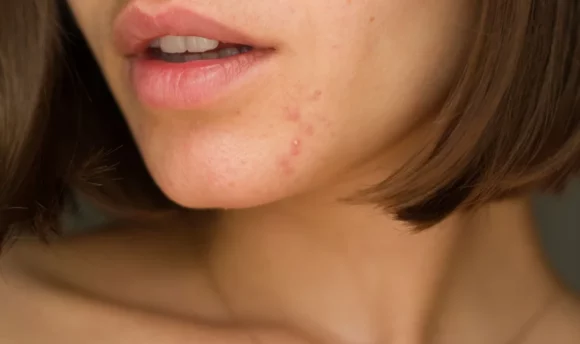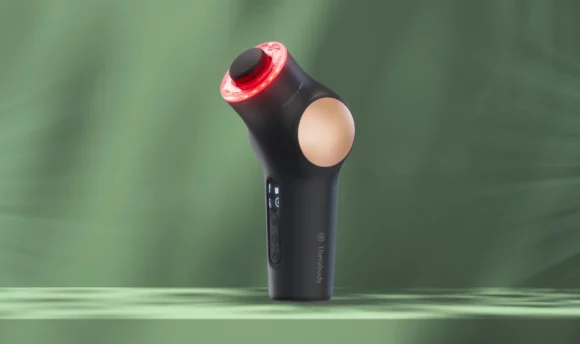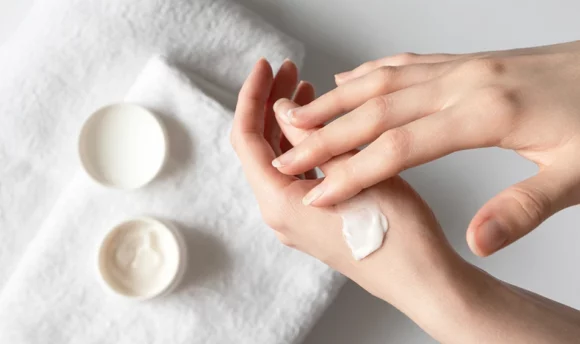Jawline Acne: Causes, Cures, and Prevention
Mastering the art of skincare for troubled areas

Acne is one of the most common conditions seen anywhere in your body, but it can be more prevalent around the face. It can be frustrating, especially if it appears in one location repeatedly, and one of the well-known places for this is the jawline.
Jawline acne is common in many people because of factors like hormonal changes caused by the menstrual cycle and increased stress levels.
While it can be challenging to clear, there are many ways to prevent breakouts around the chin and achieve noticeably smoother, brighter skin.
This post will closely examine jawline acne and analyze its causes, cures, and helpful preventive measures that can transform your daily life.
What Is Jawline Acne?
Jawline acne is the presence of acne, including pimples, blackheads, whiteheads, and other blemishes, along the lower face, chin, and jaw.
You may have occasionally experienced pimples on different areas of your skin. However, jawline and chin acne are usually painful. It is often painful to get an acne breakout along your jawline or chin, but these pimples might also have pus. However, they often start as cystic acne. These cysts are painful red bumps under your skin and can take 1 to 2 weeks to go away.
Teenagers and young adults, typically between the ages of 15 and 24, are commonly affected by acne, including around their jawline. This is due to hormonal changes during puberty.
Both men and women can experience jawline or chin acne due to hormonal fluctuations. Certain conditions, such as hormonal imbalances, may make women more susceptible to acne in these areas due to increased oil gland activity.
Some women experience an increase in chin acne during their periods as their hormone levels change. Acne in women can also be because of polycystic ovarian syndrome (PCOS), a condition in which women have cysts in their ovaries and higher-than-normal levels of male hormones.
There are different types of acne, but three types can cause breakouts on the jawline: Bacterial jawline acne, which is caused when bacteria, sebum, and dead skin cells get trapped in your pores.
Hormonal jawline acne is another type of jawline breakout caused by hormonal imbalances, while mechanical jawline acne refers to breakouts caused by physical rubbing or pressure from clothing or equipment.
Causes of Jawline Acne
Acne occurs when pores clog, creating an environment where bacteria naturally found on the skin can cause inflammation and infection. However, there might be various reasons why the pores on different body areas may get clogged. Here’s what can cause bumps to form on your jaw:
#1 Hormonal changes
Hormonal changes are one of the primary reasons for acne, which explains why so many teenagers get outbreaks. However, the same hormonal changes can occur later in life, particularly in women who are pregnant, menopausal, or menstruating.
High estrogen levels increase the production of sebum, which promotes clogged pores. High testosterone levels thicken the skin’s sebum oil, which increases the risk of clogged pores and hormonal jawline acne.
Starting or stopping birth control pills can also impact your hormone levels, which may increase the risk of hormonal acne.
#2 Poor hygiene
Certain behaviors can increase jawline acne. Resting on your hand or touching your face can transfer bacteria, oil, and dirt from your hands to your face, clogging pores and causing acne breakouts.
#3 Skincare and haircare products
Haircare products, makeup, and moisturizers may worsen your acne problems. Some products contain oil or can irritate your skin. The excess oil, dead skin cells, and irritation to the skin may create the right environment for acne to survive.
#4 Medications
Several medications, like steroid medicines and drugs for bipolar and depression, list acne as a side effect. These medications can cause hormonal fluctuations and skin oil production, leading to acne breakouts.
#5 Friction or pressure
Physical friction or pressure from clothing or equipment along the jawline or neck can lead to acne. Musical instruments like violins and others that touch your chin may cause breakouts.
Wearing sports equipment close to the face, such as thick shoulder pads, helmets with chin straps, or tight-collard shirts, can trap heat and sweat in the area, causing breakouts along the chin.
#6 Folliculitis
Folliculitis is a bacterial infection of the hair follicles, and it is more frequent in men and women who have thick, coarse hair on their jaw and chin and go for waxing or threading. If you decide to shave, you must do so carefully and neatly to avoid breakouts. Shaving can worsen pre-existing acne and cause more inflammation and skin irritation. Folliculitis can also cause fungal acne.
#7 PCOS
Polycystic ovary syndrome (PCOS) is the most common hormonal irregularity seen in women with jawline acne. One of the main features of PCOS is the overproduction of male sex hormones such as androgens in women. Excess levels of these hormones can increase sebum production, increase the risk of hormonal acne, and even affect ovulation.
How to Treat Jawline Acne
Treating jawline acne involves knowing how to care for your skin using the right techniques, products, and medications. Here are methods that will help you treat acne and enjoy a clear and smooth skin.
#1 Topical treatments
Topical treatments containing benzoyl peroxide or salicylic acid can help control acne around your jawline. Topical treatments work by clearing dead skin cells, excess oil, and dirt. Salicylic can lessen the redness and swelling of acne outbreaks while reducing the likelihood of new breakouts. Benzoyl peroxide kills acne-causing bacteria.
#2 Hormonal treatments
If you have hormonal acne around your jawline, seeking treatment from your doctor may help. Your doctor may recommend hormonal therapy. They may also prescribe birth control pills, which are also used to treat hormonal acne.
#3 Oral medications
While topicals can be great, their effectiveness in treating acne is limited. Your healthcare provider may prescribe oral antibiotics to treat cystic acne, control bacteria, and reduce inflammation.
When ingested, antibiotics reach the bloodstream and target the sebaceous glands, the main cause of breakouts. The two most prescribed antibiotics for acne include doxycycline and minocycline. Their goal is to reduce inflammation and, thus, acne breakouts.
However, antibiotics can cause resistance, so they should not be used over time. Some people may also develop negative side effects. It’s crucial to remember that antibiotics can only be used under the guidance of a healthcare provider.
#4 Avoiding touching or picking your face
Touching acne spots can be very tempting, but doing so will irritate the skin, increase the severity of the pimple, and transfer it to other areas.
Besides introducing more germs into the lesion, touching, rubbing, squeezing, or popping acne sores can worsen the infection. Squeezing an acne lesion can also push germs and dirt deeper into the skin, so the spot is more likely to be worse than before.
#5 Making diet and lifestyle changes
Certain foods, especially dairy products and foods high in the glycemic index, such as sugars and “white” carbs, may trigger acne. Avoid these triggers to help relax your skin, reduce oil production, and prevent more breakouts. Load more on a balanced diet with plenty of fruits, vegetables, and whole grains.
Despite some studies suggesting a correlation between diet and acne, the relationship is not fully understood, and dietary changes may not be effective for everyone.
It’s also essential to engage in regular physical activity. Exercise improves circulation, reduces stress, and supports overall well-being. Choose activities you enjoy, such as walking, jogging, or yoga.
Ensure you also get enough sleep and drink plenty of water. Drinking enough water promotes overall skin health and helps your kidneys flush out toxins.
A Guide to Preventing Jawline Acne: 6-Week Action Plan
Week 1-2
Select appropriate products
The first step to preventing acne along your jawline is checking every product you use on your skin, including makeup and hair. The best skincare products should be labeled oil-free, non-comedogenic, or non-acnegenic, as these indicate an absence of oily, acne-causing ingredients.
Consider products with salicylic acid or benzoyl peroxide to prevent acne. These ingredients are the most effective acne treatment options. However, they can also irritate the skin, therefore it’s important to consult with a dermatologist beforehand and start with lower concentrations to see how the skin reacts.
Establish your skincare routine
Establishing a skincare routine is important for preventing pimples on your chin. Start with a twice-daily cleansing routine, morning and night. A good face wash will remove excess oil from your face without worsening redness and inflammation.
Be gentle on your face, and apply your cleanser with a baby washcloth or a cotton pad. Use a clean washcloth each day.
Ensure you moisturize your skin after cleansing. Moisturizers nourish your skin and help regulate sebum production to prevent acne on the jawline.
Gently exfoliate your skin
Start exfoliating 1-2 times weekly with a gentle exfoliator to remove dead skin cells and unclog pores. Exfoliating your face daily can do more harm than good to your skin.
Week 3-4
Make dietary changes
Limit dairy products and high-glycemic foods intake as they may result in hormonal imbalances and inflammation. Choose leafy green vegetables and colored fruits, rich in antioxidants and nutrients that fight inflammation and may improve your skin quality.
Try to manage stress
Too much stress can cause acne. Try stress-reducing activities like listening to music, yoga, taking a bubble bath, regular exercise, or heading to bed earlier.
Have a consistent sleep routine
Go to bed and wake up simultaneously every day, even on weekends. Quality sleep helps in skin repair, collagen production, and youthful appearance.
Week 5-6
Skin assessment
Assess your skin’s response to the new routine, and look for improvements in acne, reduction in redness, and overall skin tone. If your skin is responding well, continue with the current routine. If you’re experiencing negative reactions, make appropriate adjustments.
Consult a professional if needed.
Talk to your dermatologist if you’ve tried all the options and not seen any improvement. They can help troubleshoot your skin issues and create a personalized treatment plan to help treat acne around your jawline.
Skincare Routine for Jawline Acne
A skincare routine for jawline and chin acne is important, as this area is prone to breakouts. Create a personal skincare routine, from cleansing to exfoliating to moisturizing, to help you remember all the steps to get your skin looking its best.
Pay attention to the needs of your skin while choosing the products. Select products containing benzoyl peroxide and salicylic or glycolic acid if you have oily skin.
Look for hydrating ingredients like glycerin and mild products with lactic acid or niacinamide if you have sensitive or acne-prone skin. These ingredients are less drying than those designed for oilier skin types.
When introducing new products to your skin, introduce one at a time and patch-test them to ensure they don’t irritate.
Remember that dirty towels can house bacteria and even spread new bacteria to your skin, which may result in more breakouts around your jawline. So, ensure you change your face towels and pillowcases regularly to avoid the buildup of oils and bacteria.
Advice From Our Medical Team


No matter your skin type or concerns, you need to use sunscreen daily to protect your skin from the sun. Sunscreen is essential for protecting skin from UV damage, but if your chin or jawline is prone to acne, you should use a sunscreen that won’t clog pores or make acne worse.
Look for sunscreen formulas that are non-comedogenic and free of oil.
Besides worsening active acne and acne scars, UV exposure from the sun can also cause skin cancer and premature aging. Ensure your product has an SPF of 30 or higher and offers broad-spectrum protection against UVA rays.
Contact a dermatologist who can recommend a prescription acne treatment if you’ve been treating your acne for a few weeks with little to no progress.
FAQ
Yes, stress can cause jawline acne. It increases androgen hormones, increasing hair follicles and oil glands in pores, raising the risk of acne.
With proper skincare, a healthy lifestyle, and time, jawline acne may go away. Cleansing your face in the morning and night, personalized treatments, and avoiding irritating factors can lead to clear skin.
Jawline acne is a common problem for many people. Hormonal changes, increased oil production, and poor hygiene in the jawline area cause it.
Conclusion
While jawline acne can be frustrating, it can go away in a few days with the right skincare products and proper hygiene. Always wash your hands before cleansing, avoid touching your face with your hands, and use non-comedogenic makeup and skincare products to prevent them from clogging your pores and causing acne.
Changing your lifestyle, like cleaning your pillows regularly and eating a low-inflammatory diet, might also be beneficial.
The acne on your jawline should go away if you’re consistent and patient with your skincare routine.
If you struggle with pimples around your jawline and have tried all the over-the-counter and at-home remedies, it’s essential to see a dermatologist to have a professional opinion and an effective treatment.

















































 Select your language:
Select your language: 







